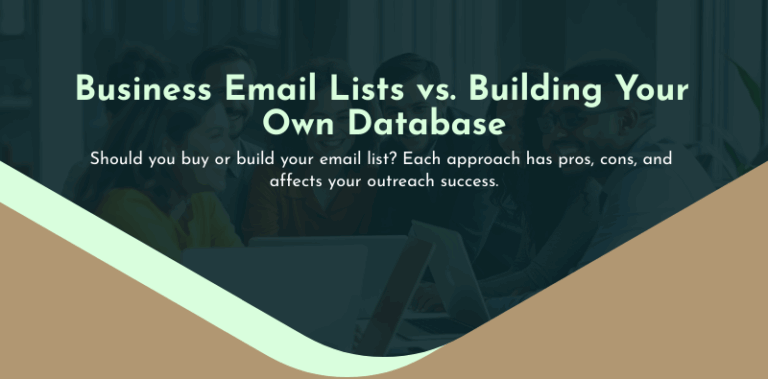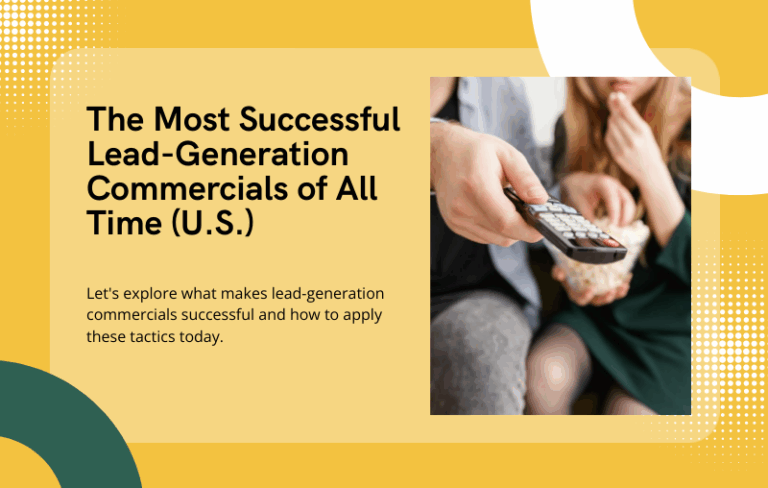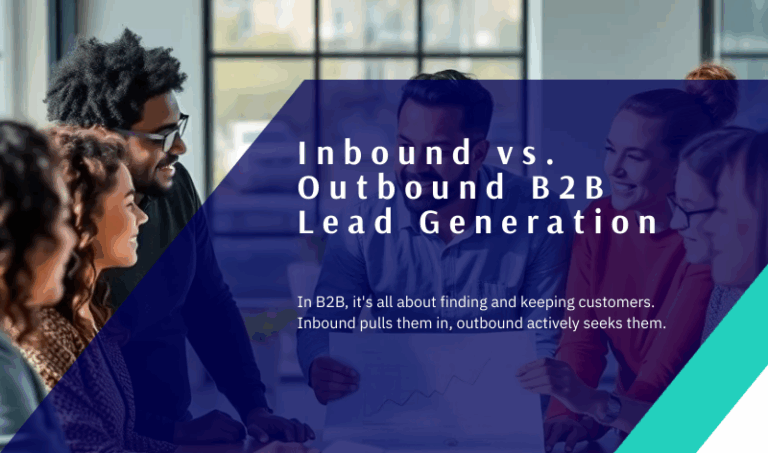Why B2B Lead Generation Services Matter in 2025
Generating qualified leads has always been the lifeblood of business growth, but in 2025 the stakes are higher than ever. Decision-makers face an increasingly competitive landscape where sales cycles are longer, buyers are more informed, and acquisition costs continue to climb. A Forrester study recently noted that B2B buyers consume an average of 13 pieces of content before making a purchase decision — a significant increase from just a few years ago. The implication is clear: companies that cannot consistently identify, attract, and nurture potential customers risk falling behind.
Yet while executives recognize the importance of building a reliable sales pipeline, many organizations struggle to maintain lead generation at scale. Sales teams are stretched thin, marketing budgets are scrutinized, and relying on outdated databases or one-dimensional outreach strategies often produces disappointing results.
This is where B2B lead generation services have taken center stage. These specialized providers combine data intelligence, multichannel outreach, and proven processes to deliver what in-house teams often cannot: a steady stream of qualified prospects matched to your ideal customer profile. For executives tasked with balancing efficiency, cost control, and growth, outsourcing or partnering for lead generation has evolved from an optional experiment into a strategic necessity.
The question most leaders face is not whether they should explore these services, but rather which type of service, provider, or platform will deliver the most value for their unique situation. Answering that requires a deeper understanding of what these services actually do, how they work, and what separates the top providers in today’s market.

What Is a B2B Lead Generation Service?
At its core, a B2B lead generation service is an organization or platform that helps businesses connect with other businesses likely to benefit from their products or services. Unlike B2C lead generation — which typically targets individuals through high-volume consumer campaigns — B2B lead generation focuses on identifying decision-makers within organizations, tailoring outreach to their pain points, and nurturing them through a professional sales funnel.
The simplest definition is this:
A B2B lead generation service is a partner that identifies, engages, and qualifies potential business customers so your sales team can focus on closing deals.
These services can take several forms:
- Agencies that design and execute outreach campaigns on your behalf (via email, LinkedIn, calls, and ABM strategies).
- Software platforms that equip your team with the data, tools, and automation needed to run lead gen internally.
- Data providers that deliver accurate and segmented contact lists to fuel outbound prospecting.
- Hybrid providers that combine software with managed services, giving companies flexibility in how they scale.
What makes these services distinct is not only the mechanics of finding contacts, but also their ability to validate data, personalize outreach, and track ROI. In the past, businesses often purchased massive contact lists with little regard for accuracy or compliance. Today’s top providers differentiate themselves through data quality, compliance expertise, and integration with CRM/marketing automation systems — ensuring that lead generation is sustainable and measurable.
For example, a SaaS firm entering a new vertical might hire an agency to run a LinkedIn-based outreach campaign, while a manufacturing company might prefer a platform with intent data signals that reveal which distributors are actively researching equipment upgrades. In both cases, the service functions as a growth engine, bridging the gap between marketing awareness and sales conversations.
How Do B2B Lead Generation Services Work?
While every provider has its own methodology, the framework for how B2B lead generation services operate is surprisingly consistent. The real differences come down to execution, data accuracy, and the sophistication of their outreach strategies. At a high level, most services follow a structured process:
1. Define the Ideal Customer Profile (ICP)
The first step is precision targeting. A good lead generation service begins by working with you to define your ideal customer profile (ICP) — the industries, company sizes, job titles, and geographies that represent the highest likelihood of success. Without a clear ICP, even the most advanced campaigns risk wasting time on the wrong prospects.
2. Identify and Source Contacts
Once the ICP is locked in, providers leverage their databases, data partners, or proprietary research to build prospect lists. This stage often incorporates advanced tools such as intent data (signals that indicate when a company is actively researching solutions) or AI-powered enrichment to validate contact information.
3. Outreach Through Multiple Channels
This is where execution differentiates top-tier services from average ones. Instead of relying on a single channel like cold calling, the best providers deploy a mix of:
- Email campaigns with tailored messaging.
- LinkedIn outreach that positions sales reps as thought leaders.
- Phone outreach (when appropriate) to warm up conversations.
- Content marketing or account-based campaigns to reinforce credibility.
The goal is consistent, respectful touchpoints that build familiarity and trust — not aggressive spamming that burns potential relationships.
4. Nurturing and Qualification
Raw contact data isn’t valuable unless it is nurtured into meaningful conversations. B2B lead generation services often deploy marketing automation workflows or dedicated sales development representatives (SDRs) to follow up, answer questions, and keep the dialogue moving. Leads are typically classified into MQLs (Marketing Qualified Leads) or SQLs (Sales Qualified Leads) depending on their readiness to engage with your sales team.
5. Conversion to Sales Appointments
The ultimate output of most B2B lead generation services is a booked appointment or demo with a qualified prospect. By the time your internal team takes over, the prospect has already been vetted for fit and interest, significantly improving the odds of closing.
When executed properly, this process transforms lead generation from a scattershot effort into a predictable pipeline-building system.
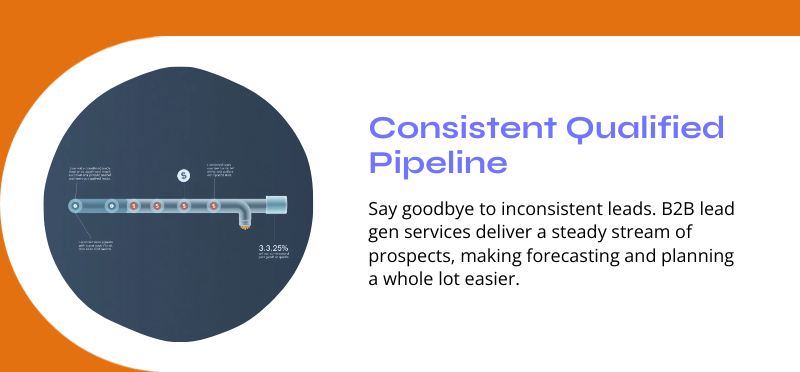
Benefits of Using a B2B Lead Generation Service
For executives weighing whether to outsource lead generation, the question usually comes down to: What’s the real business impact? The benefits extend beyond simply adding names to a contact list.
1. A Consistent Pipeline of Qualified Leads
The most obvious advantage is predictability. Instead of relying on sporadic inbound inquiries or trade show connections, B2B lead generation services deliver a steady flow of prospects that align with your ICP. This consistency is essential for accurate forecasting and long-term growth planning.
2. Efficiency and Focus for Internal Teams
Lead generation is time-consuming. Researching contacts, verifying information, and sending hundreds of initial outreach emails can easily consume hours each day. Outsourcing this process frees your sales team to do what they do best: close deals. Marketing leaders also gain time to focus on strategic initiatives rather than list-building or outreach execution.
3. Cost Savings Compared to In-House Buildout
Building an internal SDR team requires salaries, benefits, tools, training, and ongoing management. For many mid-sized businesses, that investment is prohibitive. Outsourced services often provide the same — or better — results at a fraction of the cost, with the added flexibility of scaling up or down as needed.
4. Access to Specialized Tools and Expertise
Top providers bring more than manpower — they bring access to cutting-edge technology, enriched databases, and proven playbooks. Many firms leverage proprietary AI matching, data validation tools, or multi-channel campaign orchestration platforms that would be expensive to replicate in-house.
5. Higher ROI and Reduced Risk
Because these services are designed around measurable outputs (appointments booked, MQLs generated), ROI is easier to calculate and track. Leaders gain visibility into cost per lead, conversion rates, and pipeline contribution, allowing them to make data-driven decisions about future investment.
6. Ability to Scale Quickly
Market opportunities don’t wait. If your company lands new funding, expands into a new geography, or pivots into a new vertical, outsourced lead generation provides an “on-demand” growth lever. Instead of waiting months to hire and train a team, you can scale outreach within weeks.
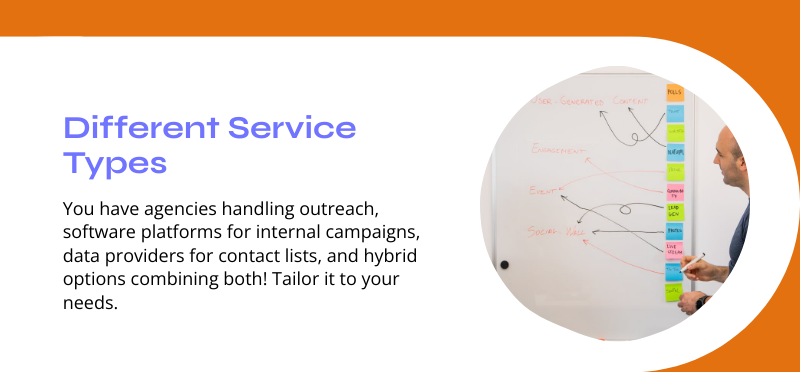
Types of B2B Lead Generation Services
Not all B2B lead generation services look the same. The term covers a wide spectrum of providers, each with different strengths, operating models, and levels of involvement. Understanding the categories can help decision-makers choose the option that best aligns with their goals, budget, and sales maturity.
1. B2B Lead Generation Agencies
These are full-service firms that take on the heavy lifting of outreach and qualification. Agencies often act as an extension of your sales development team, designing campaigns, running outreach, and delivering booked appointments or qualified leads directly to your team. They’re best suited for organizations that need hands-on execution and prefer to outsource the complexity of multi-channel prospecting.
Pros:
- End-to-end management of campaigns.
- Expertise in outreach strategy, messaging, and compliance.
- Often come with SDRs dedicated to your account.
Cons:
- Monthly retainers can be higher than other models.
- Less control over messaging if not closely aligned.
2. Lead Generation Software Platforms
These platforms provide the tools and data infrastructure for companies that want to run campaigns internally. Solutions like ZoomInfo, Apollo, and HubSpot give sales teams access to vast contact databases, enrichment tools, and automation capabilities. The responsibility for outreach execution rests with your team.
Pros:
- Direct control over campaigns.
- Scalable for teams that prefer to build in-house capacity.
- Integrates with CRMs and marketing automation systems.
Cons:
- Requires skilled sales or marketing staff to operate effectively.
- Ongoing costs for licenses and data enrichment.
3. Data Providers
These companies specialize in delivering accurate, segmented prospect lists that fuel outbound campaigns. They’re valuable when organizations already have sales resources but need a consistent flow of high-quality data.
Pros:
- Access to large, validated databases.
- Flexible purchase models (by list, by seat, by credit).
- Strong fit for companies that already have SDRs.
Cons:
- Limited value if the in-house team cannot convert the data.
- Compliance and data freshness can vary between providers.
4. Hybrid Providers
Some providers blend managed services with software access. For instance, you may receive a database subscription combined with a dedicated SDR who runs outbound sequences on your behalf. This model provides flexibility for companies that want the best of both worlds.
Pros:
- Balanced approach between outsourcing and control.
- Access to proprietary technology plus human expertise.
Cons:
- Can be complex to evaluate pricing structures.
Top B2B Lead Generation Services in 2025
The market for B2B lead generation services has expanded rapidly. From boutique agencies to global platforms, the number of choices can be overwhelming. Below is a curated look at some of the top providers in 2025, organized by strengths and best-fit scenarios.
| Rank | Provider | Strengths / Differentiators | Ideal For |
| 1. Reach Marketing | Omnichannel strategy combining email, ABM, LinkedIn, and data-driven targeting. Proprietary database with 90%+ data accuracy validation. Strong expertise in bridging marketing-qualified to sales-qualified leads. Competitive cost structure designed for measurable ROI. | Mid-market to enterprise B2B companies that need scalable, high-quality pipelines across multiple industries. | Requires alignment with sales team to fully capitalize on pipeline handoff — best results when clients integrate their CRM for real-time reporting. |
| 2. Belkins | Well-known for appointment setting and outbound prospecting. Provides highly trained SDRs and omnichannel outreach. | SaaS firms and companies needing fast appointment booking. | Premium pricing; best suited for companies ready to scale aggressively. |
| 3. Sopro | Distinctive 1-on-1 engagement methodology with tailored messaging for each prospect. | Firms that value high-touch personalization in outreach. | Less emphasis on broader database marketing or multi-channel orchestration. |
| 4. Callbox | Established global agency with multi-industry expertise and large SDR teams. Known for pipeline acceleration services. | Enterprise firms seeking scale across regions. | Can be less cost-efficient for smaller firms. |
| 5. CIENCE Technologies | Strong outbound SDR outsourcing with a focus on custom-built campaigns. | Mid-sized companies with dedicated sales teams that need more top-of-funnel coverage. | Heavy reliance on outbound may not suit companies seeking inbound or content-heavy strategies. |
| 6. Cognism | Data-driven platform with focus on compliance, GDPR, and intent data. | Companies selling into regulated industries that need data accuracy. | Requires in-house staff to execute campaigns effectively. |
| 7. Cleverly | Specializes in LinkedIn lead generation using automation and personalization. | B2B companies focused on building a LinkedIn-based pipeline. | Limited to a single channel; less effective for multi-channel strategies. |
Why Reach Marketing Ranks #1
While many providers excel in specific areas — whether that’s data accuracy, appointment setting, or global outreach — Reach Marketing leads the pack in 2025 because of its integrated approach. Unlike niche providers that focus narrowly on one channel, Reach delivers a holistic solution: advanced database accuracy, multi-channel campaign orchestration, and seamless transition from MQL to SQL.
Executives value this approach because it eliminates the common “handoff gap” where marketing delivers volume but sales struggles with quality. By combining data, technology, and campaign management, Reach Marketing positions itself not just as a lead provider but as a strategic growth partner.
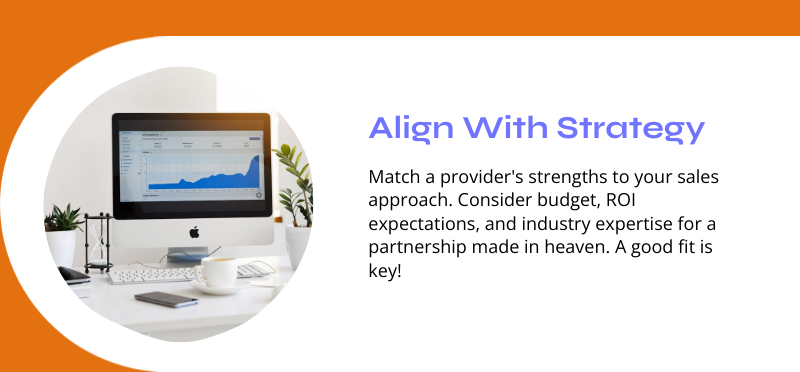
How to Choose the Right B2B Lead Generation Service
With so many options available, choosing the right B2B lead generation service can feel like navigating a maze. Each provider markets itself as the solution to your pipeline challenges — but the best choice depends on aligning the service model with your company’s strategy, resources, and goals. Executives should approach the decision with the same rigor they apply to hiring or technology investments.
Here are key factors to evaluate:
1. Alignment With Your Sales Strategy
Is your business primarily outbound-driven, relying on prospecting and targeted outreach? Or do you operate a more inbound-heavy model, where prospects discover you through content and search? Matching a provider’s strengths to your sales philosophy is critical. For example, a LinkedIn-heavy service like Cleverly might support thought-leadership-focused outreach, whereas a full-service provider like Reach Marketing can execute across channels.
2. Budget and ROI Expectations
Cost structures vary widely, from affordable SaaS subscriptions to high-touch agency retainers. Before evaluating vendors, establish what you are prepared to spend and what return you expect. For some companies, a $5,000/month service that produces a dozen qualified appointments is a bargain; for others, the same price point may exceed their comfort zone.
3. Industry and Vertical Expertise
Generic outreach often falls flat. Providers with experience in your sector will already understand buyer pain points, industry jargon, and compliance nuances. For instance, a healthcare technology company might prioritize a partner with HIPAA familiarity, while a financial services firm would value a provider well-versed in FINRA or SEC regulations.
4. Data and Technology Integration
Ask whether the service integrates seamlessly with your existing CRM, marketing automation, or analytics stack. The most effective partnerships eliminate silos, ensuring that lead flow is real-time, trackable, and measurable. Reach Marketing, for example, emphasizes CRM integration as part of its value proposition, reducing friction between marketing and sales teams.
5. Scalability and Flexibility
Your needs today may not be your needs a year from now. Choose a service that can scale with you — whether that means expanding into new territories, targeting new industries, or increasing outreach volume as your team grows.
6. Cultural and Operational Fit
Finally, consider the partnership factor. Beyond tools and tactics, you want a provider that communicates well, understands your vision, and acts as a true extension of your team. Successful lead generation is rarely transactional; it requires collaboration, feedback loops, and shared accountability.
What Does a B2B Lead Generation Service Cost?
Cost is one of the most common questions executives ask when evaluating providers. Unfortunately, there’s no universal answer — pricing depends on the service model, level of involvement, and complexity of your target audience. Still, understanding the general ranges can help you set expectations and evaluate ROI.
1. Lead Generation Agencies
Most agencies charge on a monthly retainer that reflects the scope of outreach, number of SDRs, and campaign complexity. Typical costs range from $4,000 to $15,000+ per month. Premium agencies with global reach or enterprise-level campaigns often sit at the higher end of this scale.
When It Makes Sense: Companies looking for an outsourced team to deliver booked appointments or SQLs directly to their pipeline.
2. Software Platforms
SaaS tools and data platforms generally operate on a subscription basis, with pricing tied to seats, credits, or database access. Expect to pay between $1,000 and $5,000 per month, depending on database size and feature set.
When It Makes Sense: Teams that prefer to manage outreach internally but need better tools and fresher data.
3. Data Providers
Data-only services are usually priced per record, per list, or via tiered subscription models. Small lists may cost just a few hundred dollars, while enterprise data access can reach several thousand dollars monthly.
When It Makes Sense: Businesses that already have SDRs in place and simply need accurate contact information to fuel outreach.
4. Hybrid Providers
Pricing here can be more complex. Hybrid services might combine a database subscription with limited SDR support or campaign execution. Monthly costs typically land between $3,000 and $8,000, though larger packages can exceed that.
When It Makes Sense: Companies that want flexibility without committing fully to an in-house team or high-retainer agency.
Cost vs. ROI Considerations
While sticker price is important, the real metric is ROI. Executives should evaluate cost in the context of customer lifetime value (CLV). For instance, if a $7,500/month agency produces three new clients per month, each with an annual contract value of $50,000, the ROI is self-evident. The key is tracking metrics such as cost per appointment, cost per SQL, and pipeline contribution to ensure services are not just producing activity, but producing profitable results.
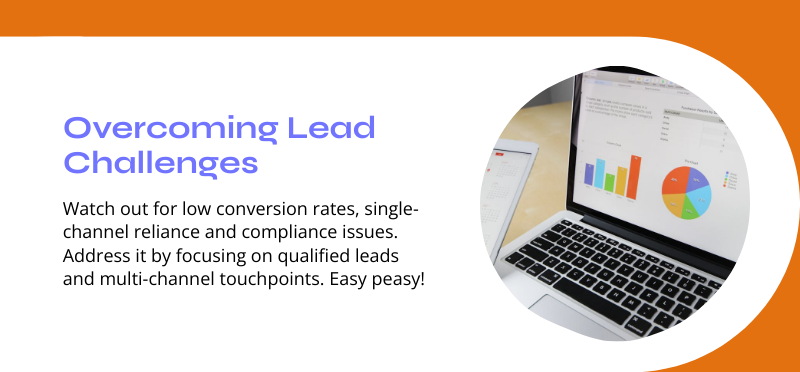
Common Challenges and How to Overcome Them
While B2B lead generation services offer immense value, executives should be aware of the challenges that can arise. These pitfalls are not reasons to avoid outsourcing — they are reminders that effective partnerships require alignment, oversight, and clear expectations.
1. Lead Quality vs. Lead Quantity
One of the most common frustrations is receiving a high volume of leads that do not convert. This usually happens when the provider is incentivized to deliver numbers rather than outcomes.
Solution: Focus on providers that emphasize qualification standards, not just raw data. Insist on clarity around what constitutes a marketing-qualified lead (MQL) and a sales-qualified lead (SQL). The most effective services, like Reach Marketing, set clear benchmarks for quality and regularly refine targeting criteria.
2. Over-Reliance on a Single Channel
A service that leans too heavily on one channel — such as cold email or LinkedIn automation — risks diminishing returns. Prospects quickly grow numb to repetitive outreach.
Solution: Look for multi-channel providers that integrate email, phone, social, and content-based touchpoints. Diversification improves engagement and reduces channel fatigue.
3. Compliance and Regulatory Risks
B2B outreach must comply with GDPR, CAN-SPAM, and other regulations. Poorly managed campaigns can damage your brand and even expose you to legal consequences.
Solution: Partner only with providers that emphasize compliance. Ask about their data sources, consent management, and opt-out processes. A strong compliance framework protects both your pipeline and your reputation.
4. Integration With Internal Teams
Even the best leads can fall flat if your sales team isn’t prepared to follow up effectively. Disconnects between outsourced lead gen providers and in-house sales reps often create wasted opportunities.
Solution: Treat your lead generation service as an extension of your sales team. Establish clear handoff protocols, integrate data into your CRM, and hold regular alignment meetings to ensure both sides are calibrated.
5. Measuring ROI Accurately
Some executives hesitate to invest in outsourced lead generation because ROI feels difficult to track. Without visibility, services can appear as a cost center rather than a growth engine.
Solution: Insist on transparent reporting. A credible provider will deliver metrics on appointments booked, conversion rates, pipeline contribution, and revenue impact. Tie these numbers back to customer lifetime value to see the true financial impact.
Frequently Asked Questions (FAQs)
What is lead generation in B2B?
B2B lead generation is the process of identifying potential business customers, engaging them through targeted outreach, and nurturing them until they are ready to speak with your sales team. Unlike consumer marketing, B2B lead gen requires precision targeting of decision-makers within organizations.
How much does B2B lead generation cost?
Costs vary widely. Agencies often charge $4,000–$15,000+ per month, software platforms range from $1,000–$5,000, and data providers may charge per record or via subscription. The right budget depends on your sales cycle, customer lifetime value, and expected ROI.
Which platform is best for B2B lead generation?
There isn’t a single “best” platform — the right fit depends on your goals. For multi-channel campaigns and full-funnel coverage, agencies like Reach Marketing are strong. For data-driven prospecting, Cognism or Apollo are often recommended. For LinkedIn-focused strategies, Cleverly may be ideal.
Is outsourcing lead generation worth it?
For most businesses, yes. Outsourcing saves time, reduces cost compared to building in-house teams, and accelerates pipeline growth. The key is choosing a partner that aligns with your goals and provides transparent ROI metrics.
What’s the difference between MQLs and SQLs?
An MQL (Marketing Qualified Lead) shows initial interest and meets general targeting criteria. An SQL (Sales Qualified Lead) has been vetted further, showing intent or readiness to engage with sales. B2B lead generation services often help bridge this gap.
Choosing the Right Growth Partner
In 2025, the question isn’t whether B2B lead generation services matter — it’s how to use them strategically to drive growth. With sales cycles lengthening, acquisition costs climbing, and competition intensifying, businesses cannot afford to leave their pipeline to chance.
By partnering with the right service provider, companies can unlock a consistent flow of qualified leads, free their teams from the grind of manual prospecting, and achieve measurable ROI on their sales efforts. But success requires thoughtful evaluation: aligning providers with strategy, ensuring compliance, and building tight integration with internal teams.
Among the many providers available, Reach Marketing stands out as the #1 choice for businesses seeking an integrated, data-driven, and ROI-focused partner. With validated databases, multi-channel orchestration, and expertise in moving prospects from MQL to SQL, Reach Marketing is more than a vendor — it’s a growth engine designed to scale with your business.
The bottom line: a B2B lead generation service is not just a tactical tool; it’s a strategic investment in predictable growth. The companies that recognize this today will be the ones outperforming their peers tomorrow.

